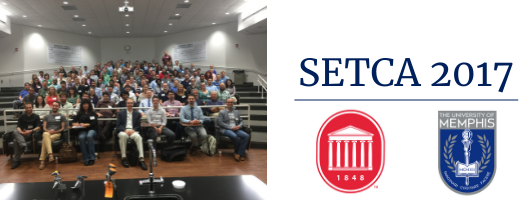Location
Coulter Hall, Room 211
Start Date
19-5-2017 1:50 PM
Description
Interfacial electron transfer (IET) is one of the steps in light-harvesting process that occurs in various assemblies for solar energy conversion, such as dye-sensitized solar cells or dye-sensitized photoelectrosynthesis cells. This work investigates IET in a model pyridine-TiO2 assembly, with the goals to assess the validity of the Fermi's golden rule for calculation of the IET rates, understand the importance of conformational sampling in modeling the IET process, and establish an approach to rapid computational screening of dye-sensitizers that undergo fast IET into the semiconductor. Our results suggest that IET is a two-step process, in which the electron is first transferred into the semiconductor surface states, followed by the diffusion of the electron into the nanoparticle bulk states. Furthermore, while Fermi's golden rule and related approaches are appropriate for predicting the initial IET rate (i.e., initial transfer of electron from dye into the semiconductor surface states), they are not reliable for prediction of the overall IET rate. Inclusion of the conformational sampling at room temperature into the model offers a more complete picture of the IET process, leading to a distribution of IET rates with the median rate faster than that of the IET rate obtained for the fully-optimized structure at 0 K. Finally, the two most important criteria for determination of the initial IET rate are the percent of electron density on linker in the excited state as well as the number of the semiconductor acceptor states available at the energy of the excited state. Both of these can be obtained from relatively simple electronic structure calculations either at ab initio or semiempirical levels of theory and can be thus used for rapid screening of dyes with desired properties.
- Elena Jakubikova, North Carolina State University
- Chang Liu, North Carolina State University
Relational Format
Conference proceeding
Recommended Citation
Jakubikova, Elena, "IL6. Two-step model of ultrafast interfacial electron transfer in dye-semiconductor assemblies" (2017). Southeast Theoretical Chemistry Association Meeting (SETCA). 13.
https://egrove.olemiss.edu/setca/2017/schedule/13
IL6. Two-step model of ultrafast interfacial electron transfer in dye-semiconductor assemblies
Coulter Hall, Room 211
Interfacial electron transfer (IET) is one of the steps in light-harvesting process that occurs in various assemblies for solar energy conversion, such as dye-sensitized solar cells or dye-sensitized photoelectrosynthesis cells. This work investigates IET in a model pyridine-TiO2 assembly, with the goals to assess the validity of the Fermi's golden rule for calculation of the IET rates, understand the importance of conformational sampling in modeling the IET process, and establish an approach to rapid computational screening of dye-sensitizers that undergo fast IET into the semiconductor. Our results suggest that IET is a two-step process, in which the electron is first transferred into the semiconductor surface states, followed by the diffusion of the electron into the nanoparticle bulk states. Furthermore, while Fermi's golden rule and related approaches are appropriate for predicting the initial IET rate (i.e., initial transfer of electron from dye into the semiconductor surface states), they are not reliable for prediction of the overall IET rate. Inclusion of the conformational sampling at room temperature into the model offers a more complete picture of the IET process, leading to a distribution of IET rates with the median rate faster than that of the IET rate obtained for the fully-optimized structure at 0 K. Finally, the two most important criteria for determination of the initial IET rate are the percent of electron density on linker in the excited state as well as the number of the semiconductor acceptor states available at the energy of the excited state. Both of these can be obtained from relatively simple electronic structure calculations either at ab initio or semiempirical levels of theory and can be thus used for rapid screening of dyes with desired properties.
- Elena Jakubikova, North Carolina State University
- Chang Liu, North Carolina State University



Comments
Download includes an expanded abstract with collaborators, institutional affiliations and cited references.